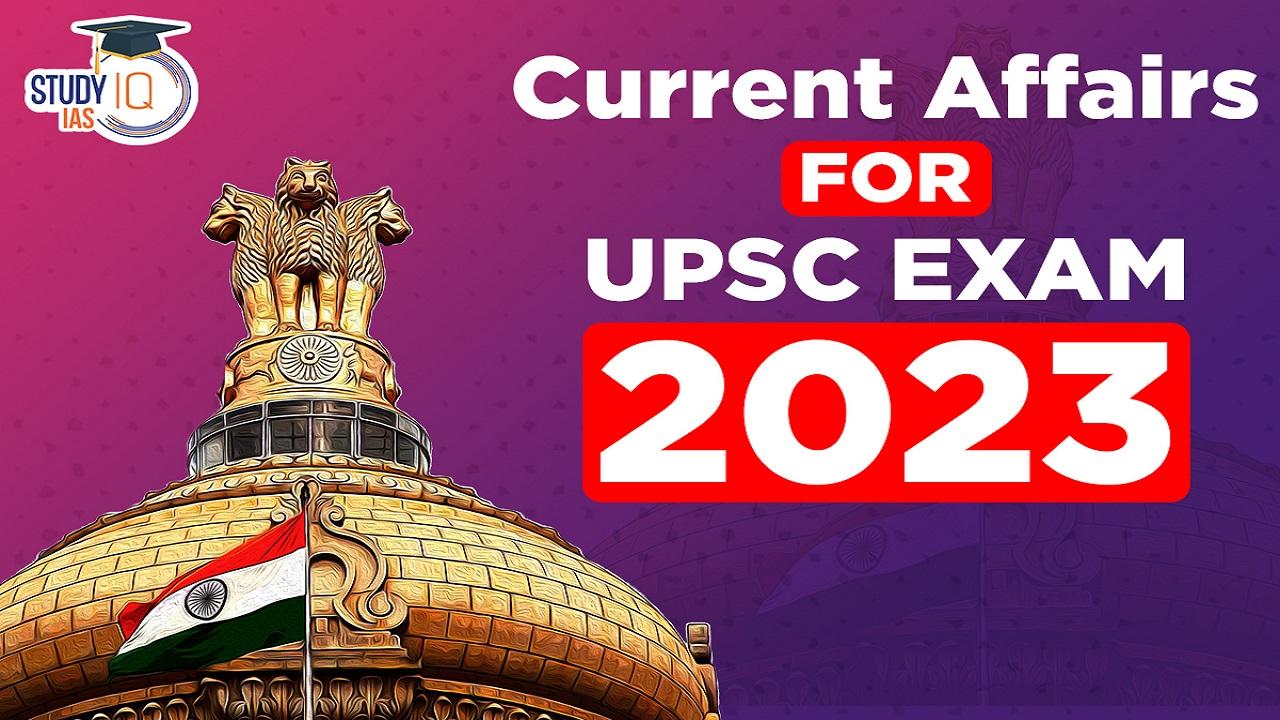Current Affairs 29th September 2023 for UPSC Prelims Exam
Pink Bollworm
Context: North India’s cotton production is under threat again due to pink bollworm infestations in Rajasthan and Haryana.
About the Pink Bollworm
- The pink bollworm is a moth that is a major pest of cotton.
- Scientific name: Pectinophora gossypiella.
- The pink bollworm is native to Asia, but has become an invasive species in most of the world’s cotton-growing regions.

- Features:
- The pink bollworm is a small, grayish-brown moth with a wingspan of about 1 inch.
- The larvae are white caterpillars with pink bands on their backs.
- The larval stage is the destructive and identifiable stage.
- The larvae can grow up to 1/2 inch long.
- Impact:
- The larvae bore into cotton bolls and feed on the seeds, destroying the cotton and reducing the yield and quality (yield losses can be as high as 50%).
- It can also reduce the quality of cotton by staining the lint and making it more difficult to process.
- It has also been observed to attack hibiscus, okra, and hollyhock plants.
About Cotton
- Cotton crops produce a soft, fluffy, staple fibre that is widely used in the textile industry.
- Conditions required for cultivation:
- Temperature: Between 21-30°C.
- Rainfall: Around 50-100cm.
- Soil Type: Well-drained black cotton soil (Regur Soil) (E.g., Soil of Deccan Plateau).
- Cotton is a water intensive crop that requires almost 75 lakh liters of water per hectare.
- Four cultivated species of cotton:
- Gossypium hirsutum: It is upland cotton native to Central America, Mexico, and the Caribbean.
- Gossypium barbadense: A tropical South American cotton with extra-long staples.
- Gossypium arboreum: Tree cotton native to India and Pakistan.
- Gossypium herbaceum: Levant cotton, native to southern Africa and the Arabian Peninsula.
- Leading cotton producing countries: China>India>United Sates>Brazil>Pakistan.
- Cotton Production in India:
- Cotton is one of the most important cash and fibre crops in India.
- It is a Kharif crop that is sown from June to July and harvested from October to January.
- Top Cotton Producing States: Gujarat > Maharashtra > Telangana > Andhra Pradesh > Rajasthan.
- Cotton is also one of the largest contributors to India’s net foreign exchange by way of exports. Due to its economic importance in India, it is also termed as “White-Gold”.
Current Affairs 28th September 2023 for UPSC Prelims Exam
Tera Hertz Range
Context: The Telecom Regulatory Authority of India (TRAI) has released a consultation paper to facilitate demand generation in Tera Hertz Range.
About the Tera Hertz Range (THR)
- The terahertz range (THR) is a region of the electromagnetic spectrum that lies between microwaves and infrared light.
- It has frequencies between 0.1 and 10 THz, or wavelengths between 3 mm and 30 μm.
- THR has some unique properties that make it useful for a wide range of applications.
- Penetration: It can penetrate many materials that are opaque to other types of radiation.
- Safety: It is non-ionizing, meaning that it does not damage DNA.
- Sensitivity: THR is also very sensitive to the chemical composition of materials, which makes it useful for spectroscopy and imaging.

- Potential applications of THR: Security screening, medical imaging, detecting food contamination and adulteration, industrial inspection, and high-speed wireless communication etc.
- However, the Terahertz technology is still in its early stages of development.
Understanding the Electromagnetic Spectrum (EM Spectrum)
- The electromagnetic spectrum is the range of all types of electromagnetic radiation.
- It includes radio waves, microwaves, infrared light, visible light, ultraviolet light, X-rays, & gamma rays.
- Properties of EM Spectrum:
- Electromagnetic radiation is transverse in nature.
- All electromagnetic radiation travels at the speed of light in a vacuum.
- But different types of electromagnetic radiation have different frequencies and wavelengths.
- Electromagnetic radiation can be reflected, refracted, and diffracted.
Global Innovation Index 2023
Context: Global Innovation Index 2023 rankings have been released by the World Intellectual Property Organization (WIPO).
Global Innovation Index (GII)
- GII tracks the most innovative economies in the world, ranking the innovation performance of around 132 economies while highlighting innovation strengths and weaknesses.
- Parameters for computing the GII include:
- Institutions
- Human capital and research
- Infrastructure
- Market sophistication
- Business sophistication
- Knowledge and technology outputs
- Create outputs
- It is published annually by WIPO.
Key Highlights of GII 2023
- India’s Rank:
- India ranked 40th out of 132 economies in the GlI 2023.
- In 2015, India stood at 81st spot and has been rising in the past eight years.
- Within central and southern Asia, India continues to lead and maintains its 40th position overall.
- India leads the lower middle-income group, performing strongly in every innovation pillar except for Infrastructure.
- India owes its success to factors like policy-driven innovation in areas like electric vehicles, biotechnology, nanotechnology, space, and alternative energy sources and implementation of Atal Innovation Mission.
- Top five innovative Countries: Switzerland>Sweden>United Sates> UK> Singapore.
- Other Highlights:
- India is among the 21 economies that outperformed for a 13th consecutive year on innovation relative to level of development along with Republic of Moldova and Vietnam.
- India, Iran, Philippines, Turkiye, Vietnam and Indonesia are among the economies within the GII top 65 that climbed fastest in the ranking in last 10 years.
World Intellectual Property Organization (WIPO)
- WIPO is a global forum for intellectual property policy, services, information and cooperation.
- It is an agency of the United Nations, with 193 member states.
- Aim: Development of a balanced and effective international IP system that enables innovation and creativity for the benefit of all.
- WIPO Madate: WIPO Convention that which established WIPO in 1967.
- Headquarters: Geneva, Switzerland
Airport Codes by IATA and ICAO
Context: The International Air Transport Association (IATA) has assigned a distinct three-letter code, ‘DXN,’ to the forthcoming Noida International Airport (NIA) in Jewar.
More on News
- DXN for Noida International Airport: The D in DXN signifies Delhi (national capital), and N stands for Noida (presence in the Western UP area) and X, signifies connectivity within India and the world.
Airport Codes
- Definition: Airport codes are unique identifiers assigned to each airport.
- Background:
- Airport coding first began in the 1930s.
- At the time, airlines and pilots chose their own two letter codes to identify destinations.
- However, by the 1940s, as the number of airports grew, a system of three letter codes was devised and standardised in the 1960s by the International Air Transport Association.
- Types: There are two main types of airport codes:
- IATA (International Air Transport Association):
- These are three-letter codes used to refer to the majority of commercial airports worldwide.
- These codes are used for passenger facing operations — on tickets, boarding passes, signages, etc.
- ICAO (International Civil Aviation Organization):
- The less common four-digit codes are assigned by the ICAO.
- They are used by industry professionals such as pilots, air traffic controllers, planners, etc.
- Example: For the Indira Gandhi International Airport in Delhi, the IATA code is DEL whereas the ICAO code is VIDP.
- IATA (International Air Transport Association):
- Process: Factors that determine the IATA code for any airport:
- How the airport wishes to identify itself: City names, airport names, and location names are some common bases for codes.
- The availability of said code: The codes are meaningful only because they are unique. This means that no two airports can have the same IATA codes.
- Common conventions, depending on the country: For instance, in India, a convention is followed where military airports extended for civilian traffic are assigned codes beginning with ‘IX’.
- Consequently, the Ranchi airport is IXR, Agartala’s airport is IXA etc.
- Similarly, in the US, all codes starting with N are reserved for the US Navy.
International Air Transport Association (IATA)
- It was founded in Havana, Cuba, on 19 April 1945.
- It is the successor to the International Air Traffic Association founded in the Hague in 1919.
- Aim:
- Inter-airline cooperation in promoting safe, reliable, secure and economical air services.
- Supports many areas of aviation activity and help formulate industry policy on critical aviation issues, including environmental concerns.
- Headquarters: Montreal, Canada
International Civil Aviation Organization (ICAO)
- It is a United Nations agency.
- It was established in 1947 by the Convention on International Civil Aviation (1944) known as Chicago Convention.
- Functions:
- Air Navigation Capacity and Efficiency: Upgrading the air navigation and aerodrome infrastructure and developing new procedures to optimize aviation system performance.
- Security and Facilitation: Enhance global civil aviation security and facilitation.
- Economic Development of Air Transport: Foster the development of a sound and economically-viable civil aviation system.
- Environmental Protection: Minimize the adverse environmental effects of civil aviation activities.
- Headquarters: Montreal, Canada
M.S. Swaminathan
Context: M S Swaminathan, the father of India’s Green Revolution and a renowned Indian agricultural scientist, recently passed away.
M.S. Swaminathan (1925-2023)
- Mankombu Sambasivan Swaminathan popularly called as M S Swaminathan was a renowned agricultural scientist and geneticist.
- Awards Received by Him:
- First Recipient of World Food Prize (1987)
- Padma Shri, Padma Bhushan and the Padma Vibhushan
- H K Firodia Award
- Lal Bahadur Shastri National Award
- Indira Gandhi Prize
- Ramon Magsaysay Award (1971)
- Albert Einstein World Science Award (1986)
- First Recipient of World Agriculture Prize (2018), instituted by the Indian Council of Food and Agriculture.
- First foreigner to receive the Golden Heart Presidential Award of Philippines.

- The M S Swaminathan Award:
- Biennial award constituted by Retired Indian Council of Agricultural Research Employees Association and Nuziveedu Seeds Ltd. for honoring M.S. Swaminathan.
- Instituted in 2004 to recognise lifetime contributions of eminent persons who have made outstanding contributions to food security and sustainability of agriculture in India.
- The award carries a Cash prize of Rs.2 lakhs, a Medal, and a Citation.
- The award is open, irrespective of his/her nationality.
- Swaminathan Commission:
- In 2004, Swaminathan was appointed as chair of the National Commission on Farmers, to look into farmer distress amid alarming suicide cases.
- The commission suggested Minimum Selling Price to be at least 50% more than the weighted average cost of production.
Role of M.S. Swaminathan in Green Revolution
- Father of India’s Green Revolution: M S Swaminathan was a pivotal figure in the development of India’s Green Revolution.
- Green Revolution: A period of scientific agricultural advancement in the mid-1960s that involved growing high-yielding variety seeds, adequate irrigation facilities and fertilisers to Indian farmers in regions of Punjab, Haryana and western Uttar Pradesh.
- High-Yielding Varieties of Crops:
- Produced using a combination of traditional breeding steps and biotechnology, which includes genetic diversity.
- Short-straw or dwarf varieties of crops like rice and wheat which formed the basis of India’s Green Revolution were spearheaded by M S Swaminathan.
- HYVs grown during the Green Revolution: IR8 (variety of rice), Kalyan Sona and Sonalika (varieties of wheat).
- Yield Gap: It is the difference between the potential or maximum achievable yield of a crop and the actual realised yield for a given area.
- During the Green Revolution, M S Swaminathan focused on increasing productivity from existing farmlands using HYVs in order to tackle the threat of famine.
- Cytogenetics: It is study of chromosomes (DNA-carrying structures) and how they related to hereditary characteristics and traits.
- Identifying traits such as resistance to diseases, drought, and pests in crops are applications of cytogenetics.
- Hexaploid Wheat (Triticum Aestivum): It contains six sets of chromosomes.
- It is among the most widely cultivated cereal crops across the world and is also called “bread wheat”.
- MS Swaminathan is associated with research on the cytogenetics of hexaploid wheat.
- Carbon Fixation: It is the process by which crops capture carbon dioxide from the atmosphere and convert it into organic compounds like sugars and starches through photosynthesis.
- Grass species either use C3 or C4 classes of photosynthetic pathway for carbon fixation.
- Research on the C4 rice plant was started under Dr. Swaminathan when he was the Director General of International Rice Research Institute.


 Indian Sex Ratio 2024, NFHS-5 Survey Est...
Indian Sex Ratio 2024, NFHS-5 Survey Est...
 Kargil Vijay Diwas 2024, Date, History a...
Kargil Vijay Diwas 2024, Date, History a...
 SSC CGL Apply Online 2024, Last Date is ...
SSC CGL Apply Online 2024, Last Date is ...

















